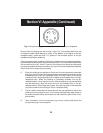
12
RECEIVING SSB SIGNALS
There are three types of signals presently used for communications in the Citizens
Band: AM, USB, and LSB. When the MODE switch on your unit is placed in the AM
position, only standard double-sideband, full carrier signals will be detected. An SSB
signal may be recognized while in the AM mode by its characteristic “Donald Duck”
sound and the inability of the AM detector to produce an intelligible output. The USB
and LSB modes will detect upper sideband and lower sideband respectively, and
standard AM signals.
Section IV Operation (Continued)
SSB reception differs from standard AM reception in that SSB receiver does not require
a carrier or opposite sideband to produce an intelligible signal. A single-sideband
transmitted signal consists only of the upper or the lower sideband and no carrier is
transmitted. The elimination of the carrier from the AM signal helps to eliminate the
biggest cause of whistles and tones heard on channels which make even moderately
strong AM signals unreadable. Also, SSB takes only half of an AM channel, therefore two
SSB conversations will fit into each channel, expanding the 40 AM channels to 80 SSB
channels. The reduction in channel space required also helps in the receiver because
only
half
of the noise and interference can be received with 100% of the SSB signal.
An SSB signal may be received only when the listening receiver is functioning in the
same mode. In other words, an upper sideband signal (USB) may be made intelligible
only
if the receiver is functioning in the USB position.
If a lower sideband (LSB) signal is heard when the receiver is in the USB mode, no
amount of tuning will make the signal intelligible. The reason for this may be
understood if you consider that when the modulation is applied to the transmitter’s
microphone in the USB mode, the transmitter’s output frequency is increased whereas
in the LSB mode the transmitter’s output frequency is decreased. The result in listening
to the receiver is that when the MODE switch is in the proper position (either USB or
LSB), a true reproduction of single tone of modulation will result, and if the tone is
increased in frequency (such as a low-pitched whistle or a high-pitched whistle) you
will hear the increase in the output tone of the receiver. If the incorrect mode is selected,
an increase in tone of a whistle applied to the transmitter will cause a decrease in the
resultant tone from the receiver.
Thus when a voice is used in place of a whistle or tone, in the proper listening mode
the voice will be received correctly whereas in the incorrect mode, the voice will be
translated backwards and cannot be made intelligible by the voice lock control. When
listening to an AM transmission, a correct sideband is heard in either mode since both
upper and lower sideband are received.


















